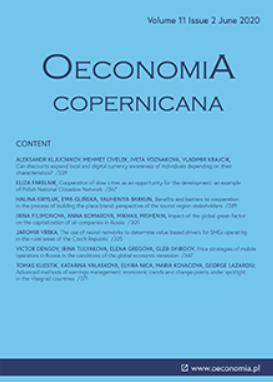Analysis of socio-economic spatial structure of urban agglomeration in China based on spatial gradient and clustering
Analysis of socio-economic spatial structure of urban agglomeration in China based on spatial gradient and clustering
Author(s): Li He, Jian'ge Tao, Ping Meng, Dan Chen, Meng Yan, Laszlo VasaSubject(s): Human Geography, Social development, Rural and urban sociology, Economic development, Socio-Economic Research
Published by: Instytut Badań Gospodarczych
Keywords: economic and social development; urban agglomeration; Central Plains Urban Agglomeration (CPUA); clustering; spatial gradient;
Summary/Abstract: Research background: Previous studies on the economic and social development of urban agglomerations mostly focus on a single primacy comparative analysis and efficiency evaluation. Spatial structure differentiation is an important feature of urban agglomeration. The lack of economic and social analysis on the spatial structure makes it impossible to determine the development positioning of each city in the urban agglomeration, which affects the sustainable economic development ability of these areas. Purpose of the article: The objective of the article is to analyze the spatial development law and experience of urban agglomeration, this study explores the practice of economic and population spatial structure of city areas in China. For this purpose, CPUA and its central city Zhengzhou was taken as an example, the spatial gradient structure of example was analyzed. Methods: Using economic and population data of 32 cities in this region, growth pole theory, and pole-axis theory, the economic and population spatial structure of urban agglomeration, the spatial gradient structure of central cities in urban agglomerations were analyzed with the method of cluster about radiation index. Findings & value added: (1) In the process of the formation of CPUA, the geographical spatial pattern plays a decisive role in economic and social development. This is an experience from developing countries. (2) CPUA presents a gradient development pattern with Zhengzhou as the center, and economic and social development gradually radiates to the metropolitan area, the core development area, and the character development demonstration area. (3) The economic and social gradients of Zhengzhou, the central city, present the hierarchy rules and characteristics which are driven by the Beijing-Guangzhou-Railway axis and the Longhai-Railway axis. (4) The central city of Zhengzhou still presents insufficient primacy in regional development, which shows that Zhengzhou accounts for 6% of the population of the Central Plains Economic Zone and 14% of GDP, and insufficient agglomeration. Different countries at different stages of economic development have different urban agglomeration development models. The conclusions from China provide new decision-making ideas and methods for spatial structure research and development strategy analysis of urban agglomerations.
Journal: Oeconomia Copernicana
- Issue Year: 12/2021
- Issue No: 3
- Page Range: 789-819
- Page Count: 31
- Language: English

